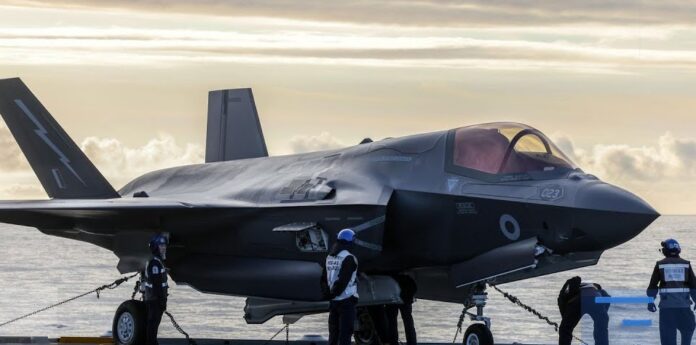Starmer orders nuclear-capable F-35 jets, reviving RAF’s airborne deterrent after 30 years
The UK will reintroduce airborne nuclear capability to its armed forces for the first time in over three decades, with Prime Minister Sir Keir Starmer confirming plans to purchase at least 12 US-made F-35A stealth fighter jets capable of carrying nuclear bombs.
Speaking at a NATO summit in The Hague, Starmer said the new aircraft would form part of NATO’s nuclear deterrence mission, marking Britain’s most significant nuclear posture upgrade since the Cold War. The jets, which will be stationed at RAF Marham in Norfolk, will be equipped to deliver US-provided B61 nuclear warheads during conflict, joining a mission already shared by a few NATO members, including Germany, the Netherlands and Belgium.
“In an era of radical uncertainty, we can no longer take peace for granted,” Starmer declared. “These F-35 dual-capable aircraft will herald a new era for our world-leading Royal Air Force and deter hostile threats to the UK and our allies.”
This announcement signals a dramatic policy shift, bringing airborne nuclear strike capability back to the RAF for the first time since Britain scrapped its free-fall bombs in the 1990s. It also sends a clear message to both Russia and China, who are expected to react angrily to the move, and to Donald Trump, whose recent remarks questioning America’s commitment to NATO have rattled European leaders.
Trump’s arrival in The Hague was preceded by speculation over whether he would uphold NATO’s Article 5—a core principle of collective defence. In response, NATO members agreed to a new target of spending 5% of GDP on defence by 2035. Britain’s contribution: bolstering its nuclear role within the alliance.
The F-35A, unlike the B-variant currently flown by the Royal Navy and RAF from aircraft carriers, operates from land, has greater range, and can be armed with nuclear weapons. The UK currently has around three dozen F-35B aircraft, far short of the 138 total originally planned. This new purchase won’t increase the overall aircraft count but will diversify the fleet—a decision long pushed for by the RAF, and quietly resisted by the Royal Navy.
While the government didn’t release a specific timeline or cost for the deal, the Ministry of Defence described it as “the biggest strengthening of the UK’s nuclear posture in a generation.”
Defence Secretary John Healey supported the move, citing a recent Strategic Defence Review that warned of “new nuclear risks.” However, the public version of that review stopped short of explicitly recommending the purchase. Lord George Robertson, the review’s lead author and a former defence secretary, admitted the panel had considered the idea but lacked enthusiasm. “When I was defence secretary, I got rid of the free-fall bombs,” he said bluntly.
Nonetheless, NATO Secretary General Mark Rutte welcomed Britain’s decision. “The UK has declared its nuclear deterrent to NATO for many decades,” he said. “This is yet another robust British contribution.”
The F-35 programme is led by US defence giant Lockheed Martin, but British firm BAE Systems also plays a key role in manufacturing. The Defence Ministry says this order will help sustain 20,000 UK jobs tied to the global F-35 supply chain.
As Starmer eyes closer defence ties with Washington and seeks to reassure a NATO shaken by Trump’s unpredictability, Britain’s renewed role in nuclear deterrence places it firmly back in the strategic cockpit.
BBC
The UK will purchase 12 US-made F-35A jets capable of carrying nuclear bombs, marking a major shift in Britain’s nuclear posture and joining NATO’s airborne nuclear mission. Prime Minister Sir Keir Starmer will announce the move at this week’s NATO summit, calling it “the biggest strengthening of the UK’s nuclear posture in a generation.”
The jets, to be based at RAF Marham, Norfolk, can carry US B61 nuclear bombs already stockpiled in Europe. Britain’s only nuclear delivery system since 1998 has been the Trident submarine-launched missiles.
The RAF currently flies the F-35B variant, which has limited range and weapons capacity. Defence experts say F-35As provide longer range and more firepower. However, actual use of US-controlled bombs would require approval from the US and NATO leadership, raising sovereignty concerns.
The move is part of a broader strategy to boost defence spending to 5% of GDP by 2035, amid heightened nuclear threats globally and growing pressure within NATO.
THE TELEGRAPH
The UK will equip its Royal Air Force with nuclear-capable aircraft for the first time since 1998, marking a major shift in defence policy. At the NATO summit in The Hague, Prime Minister Keir Starmer announced the purchase of 12 American F-35A fighter jets capable of carrying US-made B61 nuclear bombs, unlike the UK’s current F-35B fleet. This move returns Britain to a Cold War-era capability, as RAF jets lost their nuclear role with the retirement of the Tornado. Starmer justified the decision by citing “radical uncertainty” and rising global threats, including the proliferation of nuclear weapons and disruptive technologies. The government’s new national security strategy warns of a potential direct threat to the UK homeland, calling for active preparation. While the F-35A aircraft will enhance NATO’s nuclear mission, any use of these weapons would still require joint authorisation from the US President and UK Prime Minister. The jets will be based at RAF Marham and support jobs across the country.
